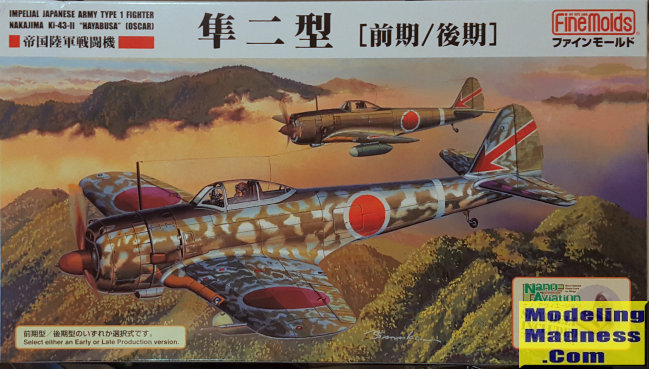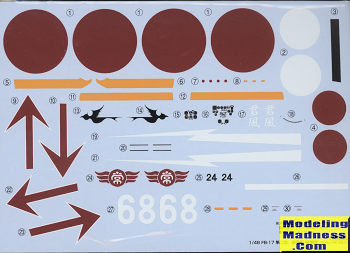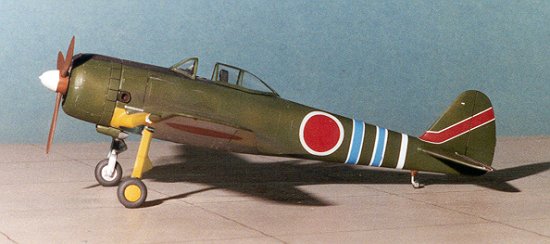
Fine Molds 1/48 Ki-43-II 'Oscar'
| KIT #: | FB17 |
| PRICE: | 3000 yen SRP |
| DECALS: | Four options |
| REVIEWER: | Scott Van Aken |
| NOTES: | 2014 boxing |

| HISTORY |
Prototypes for the Ki-43-II flew in February 1942. The Ha-25 engine was upgraded with the 2-stage supercharger, thus becoming the more powerful Nakajima Ha-115 engine, which was installed in a longer-chord cowling. The new engine turned a three-bladed propeller. The wing structure, which had suffered failures in the Ki-43-I, was strengthened and equipped with racks for drop tanks or bombs. The Ki-43-II was also fitted with a 13 mm armor plate for the pilot's head and back, and the aircraft's fuel tanks were coated in rubber to form a crude self-sealing tank. This was later replaced by a 3-layer rubber bladder, 8mm core construction; with 2mm oil-proof lamination. The bladder proved to be highly resistant against 7.7mm bullets, but was not as effective against larger calibers.The pilot also enjoyed a slightly taller canopy and a reflector gunsight in place of the earlier telescopic gunsight. Nakajima commenced production of the Ki-43-II at its Ota factory in November 1942. Production was also started at the Tachikawa Hikoki KK and the 1st Army Air Arsenal (Tachikawa Dai-Ichi Rikugun Kokusho), also at Tachikawa. Although Tachikawa Hikoki successfully managed to enter into large-scale production of the Ki-43, the 1st Army Air Arsenal was less successful – hampered by a shortage of skilled workers, it was ordered to stop production after 49 Ki-43s were built. Nakajima eventually ceased production in mid-1944 in favor of the Ki-84 Hayate, but the Tachikawa Hikoki continued to produce the Ki-43.
Here is a rundown of all the Ki-43-II variants.
| THE KIT |
 I'm
not sure just when this kit was initially released, but I have to think it was
before the Hasegawa Oscar. External detail is as good as anything you will find
today. I did find a touch of flash on a few parts, but nothing major. Interior
is six parts and there is nice sidewall detail. Decals are provided to help out.
There are also some plastic seat belts provided. It will be interesting to see
how these work when the kit is built.
I'm
not sure just when this kit was initially released, but I have to think it was
before the Hasegawa Oscar. External detail is as good as anything you will find
today. I did find a touch of flash on a few parts, but nothing major. Interior
is six parts and there is nice sidewall detail. Decals are provided to help out.
There are also some plastic seat belts provided. It will be interesting to see
how these work when the kit is built.
One thing to keep in mind is that you need to decide on an early or later aircraft pretty quickly in the build. Doing each variant requires things to be removed and different holes to open as well as some different parts. One area is the engine. This consists of a nicely detailed main engine with different prop gear boxes. Once that and the cockpit are done, they are closed in the fuselage halves.
Wings are single lower piece with upper halves. One needs to open holes if using pylons. Note that there are separate drop tanks depending on version. Tailplanes are single pieces and slot in place. On the underside are nicely done landing gear and you can model the plane gear up. Moving back to the top are the head rest, two piece canopy/windscreen, prop and various lights and smaller bits. That pretty well does it as this is not a parts intensive kit. A standing pilot figure is also included.
Kit instructions are well done and offer both Tamiya and Gunze paint references. You will need to paint the yellow wing ID markings and the black anti-glare panels. There are six markings options.
The first one is is an early production plane as are the next two. This one is from the 64th Hiko Sentai, 2nd Chutai in Burma during 1943. It is Nakajima dark green upper and unpainted metal lower.
Number 2 is from the 59th Hiko Sentai, 3rd Chutai piloted by Sgt Tomio Hirohata in New Guinea in 1943. Like all the rest it is in overall unpainted metal with a black anti-glare panel. Mottling is very light.
 Next is a 50th Hiko Sentai 3rd Chutai plane flown by Sgt.Satoru Anabuki in
Burma during 1943. Slightly heavier mottling.
Next is a 50th Hiko Sentai 3rd Chutai plane flown by Sgt.Satoru Anabuki in
Burma during 1943. Slightly heavier mottling.
The first of three later production aircraft is Major Masao Matsuo's 48th Hiko Sentai when based in China in 1944. Fairly heavy mottling.
5th is Capt. Hideo Miyabe's Burma plane from 1943. It was with the 64th Hiko Sentai.
Finally an uncamouflaged aircraft with the Hitachi flying school in Japan 1944.
Decals are nicely printed and should prove to work well.
| CONCLUSIONS |
 I
am fond of the Fine Molds kits as they are almost as nice as the Hasegawa
offerings and have a lower parts count and therefore a lower fiddly factor. The
molds have held up well over the years and the kits come with a nice selection
of markings. Add to it that they are fun to paint the camo schemes and you have
a winner.
I
am fond of the Fine Molds kits as they are almost as nice as the Hasegawa
offerings and have a lower parts count and therefore a lower fiddly factor. The
molds have held up well over the years and the kits come with a nice selection
of markings. Add to it that they are fun to paint the camo schemes and you have
a winner.
Here is a bonus photo of the last FM Ki-43-II that I built. It is an early version. As you can see, it does make a nice model. Aftermarket decals on this one.
| REFERENCES |
https://en.wikipedia.org/wiki/Nakajima_Ki-43
March 2020 Copyright ModelingMadness.com. All rights
reserved. If you would like your product reviewed fairly and
fairly quickly, please
contact
the editor
or see other details in the
Note to
Contributors.
Back to the Main Page
Back to the Review
Index Page
Back to the Previews Index Page